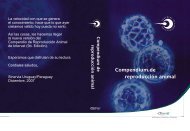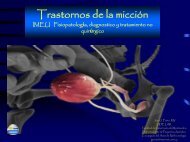Necrotic Enteritis: a Review - Sinervia
Necrotic Enteritis: a Review - Sinervia
Necrotic Enteritis: a Review - Sinervia
- No tags were found...
Create successful ePaper yourself
Turn your PDF publications into a flip-book with our unique Google optimized e-Paper software.
Condition caused by the toxins ofClostridium perfringensResults in damage of the intestinal mucosa(thickened and lined with apseudomembrane; severe necrosis withformation of diphteric membrane)
Economic losses:• loss weight gain, higher time to market, poorflock condition, increased mortality, increasedproduction costs (low feed conversion,antibiotics), secondary infections, etc.
Intestinal villi
Electron picture of VILLI: good!x 62
Electron picture of VILLI: poor!x 62
Normal
Cholangiohepatitis
• Bacteria• Rod-shaped• Spore-forming• Gram-stain positive• Anaerobic
Clostridium lives in soil…also poultry dust, feed, feces, litter.
Clostridium prefers high pHChinaMississippiRiver USASE AsiaEgyptEuropeMexico…this is necrotic enteritis country
Anaerobic culture• Use special anaerobic culture swabs• Swab fresh intestinal contents or intestinalwall• Submit to lab ASAP to avoid overgrowth• Samples in formalin.• Do not take blood samples.• New diagnostic kits????
Clostridium hemolyzes red blood cells
Clostridium produces toxins that attackcells
CpTypeABCDE______Toxin______ +++ + ++ +- - --- -+ - + -+ - - +Associated PathologyDiarrhea (foals, pigs…)<strong>Necrotic</strong> <strong>Enteritis</strong> in poultryDysentery in newborn lambsHemorrhagic enteritis in newborncalves and foalsEnterotoxemia in sheep<strong>Necrotic</strong> enteritis in piglets, lambs,calves, and foalsEnterotoxemia in sheep<strong>Necrotic</strong> <strong>Enteritis</strong> in poultryEnterotoxemia in lambs, sheep,calves and goatsEnterotoxemia in calves
Present in normal intestinal microfloraSome may not be able to produce toxinNatural non-toxin producing strainMay only produce toxin when “turnedon”
Eighth Edition of Diseases of Poultry1984 PrintChapter 13 - Miscellaneous Bacterial Diseases–Botulism–Other Clostridial Infections–Gangrenous Dermatitis and <strong>Necrotic</strong><strong>Enteritis</strong>“Incidence of infection is low and probablydepends on injury or infection to destroy tissue”“Clostridial infections are not thought to becommon in birds, and economic loss is small”
Ninth Edition of Diseases of Poultry1991 Print• Chapter 11 – Clostridial Diseases- Complete Sections on Gangrenous Dermatitis and<strong>Necrotic</strong> <strong>Enteritis</strong>• Current Poultry Industry Health Surveys- <strong>Necrotic</strong> <strong>Enteritis</strong> Makes the “Top 5 List” in All ofThem
Clinical• Mortality• MorbiditySubclinical• Reduced weight• Reduced growth rate• Impaired FCRHofacre
• Disease of the digestive tract ofsusceptible hosts• Any age susceptible• Caused by one or more species ofEimeria.• A self-limiting disease• Important and costly diseases• Man-made disease
- Excessive subclinical coccidial presence- High oocyst counts and microscopic tissuedamage during the 4 th and 5 th weeks.
OPGNE occurs here !500004500040000350003000025000200001500010000500007d10d 13d 16d 19d 21d 24d 27d 30d 33d 36dAge
Broiler Growth CurveEarlyLate0 7 14 21 28 35 42 49 56Ross 308Days
Which Cocci Opens the Door for N.E.?50403020100% <strong>Necrotic</strong> <strong>Enteritis</strong> MortalityNo Cocci CP only EA EM EA/EMDr. Chuck Hofacre
Manage by:Coccidiosis vaccination programs
Reduced in-feed antibiotic efficacy due to:-Intensive use of antibiotics (wheatration, yellow bird programs,Clostridium-prone environments)- Half-level use to reduce cost
Manage by:-Alternative antibioticstrategies- Enradin!
High protein diets – source of proteinsHigher the Protein – the easier to induce NEoutbreakHigh Levels of Animal By-Products (Fishmeal,Meat & Bone MealsAnimal By-Products Commonly HeavilyContaminated with Clostridium sp. Spores
Protein Source and QualityManage by:• Feeding lower protein and higher (synthetic) aminoacid•Feed all vegetable diets to flocks at risk• Avoid questionable quality by-products (hairs ingizzard!)• Avoid Trypsin inhibitors in soybean meal
Grain Source and QualityHigh Levels of Specific Grains•Wheat•Rye•Barley
Grain Source and QualityWheat, Barley, Rye:• Increased Intestinal Irritation• Decreased Digestibility• More Nutrients for the Clostridia Organism• Increased Mucous Production
Goblet cellsW/R: ileum (100 x)M: ileum (100x)Prof. Ducatelle
Grain Source and QualityManage by:• Enzymes, microflora treatments toimprove digestibility• Avoid these grains in flocks at risk!
Dramatic Change in DietStarter to Grower Change• Common to See Diarrhea With ThisFeed Change• Dramatic Changes in Diet Formulation• Results in Increased Intestinal Irritationor Mucous Production
Litter Type and ConditionRice or Oat Hulls•Increased Consumption by Birds- Increased Cocci/Bacteria Challenge- Increased Intestine Irritation
Litter Type and ConditionIncreased Litter Moisture•Increased Cocci Challenge•Increased Bacteria Growth•Litter Moisture Secondary to Diarrhea
Manage byLitter Type and Condition•Avoid the more edible litter in flocksat risk•Close monitoring and managementof litter in flocks at risk
SummaryCauseOther factors• C.perfringens• Infectious agents• Managerial• Nutritional• In-feed preventive treatment
NetvaxNE Control by Vaccination
Background• Oil emulsion for injection• Contains Clostridium perfringens type A alphatoxoid (>6.8 IU HIA)• 0.5 ml administered by intramuscular injection intothe breast• First dose to be given at 10 to 14 weeks of age• Second dose to be administered 4 to 10 weeksafter the first vaccination and no later than 6weeks before the onset of lay
Indications for Use• For the active immunization of chickens toprovide passive immunisation againstnecrotic enteritis to their progeny, duringthe laying period• To reduce mortality and the incidence andseverity of lesions caused by Clostridiumperfringens Type A induced necroticenteritis
Reduced impact from early C.perfringens growth may alter thedynamics of intestinal microflora throughthe life of the flock.1 4 7 10 13 16 19 22 25 28 31 34 37 40 43 46 49Days of age
Maternal antibodyprotection for earlychallengeMay prevent tissuedamage thatencourages further C.perfringens growth ortoxin production thatwould causeproblems later.1 4 7 10 13 16 19 22 25 28 31 34 37 40 43 46 49days of ageOocysts excreted
• Improved livability• Improved weight• Improved feed conversion
To use an efficient AGPAntibiotic Growth PromotantCp
ENRADIN F-80
ENRAMYCIN CHARACTERISTICS• ACTIVE INGREDIENT: ENRAMYCIN- PRODUCED BY STREPTOMYCES FUNGICIDICUS• POLYPEPTIDE ANTIBIOTIC- ANTIBACTERIAL ACTIVITY INHIBITS BACTERIA WALL FORMATION(PEPTIDOGLYCANS).• ACTIVE ON GRAM+ BACTERIA- SELECTIVE SPECTRUM MANY MAJOR ENTERIC PATHOGENES ARE G+(Clostridium, Streptococcus,...)• VERY ACTIVE ON CLOSTRIDIUM PERFRINGENS- NECROTIC ENTERITIS (clinical as well as sub clinical)
Gut, no enramycinPathogenicbacteria'sNon-pathogenicbacteria's
ActionenramycinNon-pathogenicbacteria'sPathogenicbacteria's
MIC Comparison of Clostridium perfringens between Enradin F-80 and Avilamycin insamples collected from farms using Avilamycin
RecommendationsPeriodFeed RateBroilers•Starter•Grower•Finisher•6 or 8 ppm•4 or 6 ppm•3 or 4 ppmBreeders•Start : Until 4 weeks•From 5 to 18 weeks•From 19 to 24 weeks•During the productionof eggs•10 ppm•8 ppm•6 ppm•4 ppmLayers •During lay •5 ppm
Remember• Use higher dosage in the pre-starter and the starter feed.• Avoid big changes in dosage between different feeds:– Starter feed : 10 ppm– Grower feed : 4 ppm NO!• Do not make bigger differences between feeds than 3 ppm.example– Starter feed : 10 ppm– Grower feed : 7-8 ppm• If you can use a growth promotant in slaughter feed, then Enramycin isthe best product for this situation. Use only 3 or 4 ppm, it's sufficient.• You can use Enradin in rotation programs : Change 6 months
Conclusion: ENRADIN F-80•Acts in very low dosage;•Not absorbed in the gut;•No residue in the meat;•Not used in human or veterinarytherapy;•No resistance reported;•Acts effectively in G+ organisms;•Stable during the pelleting process andin feeds;•Reduces wet droppings in poultry;•Depresses ammonia-producing organisms,thereby reducing ammonia levels in theintestinal contents and blood;•Improve performance.
Follow the Leader in intestinal health!THANK you all for your attention
Thank you very much!www.ihc-poultry.com






